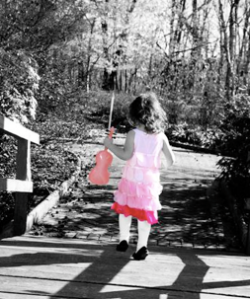Common Misconceptions About A Career in Violin (also Viola & Cello)
Share
by Rozanna Weinberger

Young Shira follows her unique path..
While I don’t really enjoy drawing attention to how far I go back, I can confidently say there was a time when the choice for string players primarily included orchestra, chamber music, teaching and if you were very lucky, a solo career. There also seemed to be a more widespread appeal and respect for classical. No doubt the lack of music education for many children has meant lack of exposure to these refined art forms.
Still its interesting to note string players have gravitated with greater frequency to idols like Jazz, New Age, Rock,etc. In modern times, the chances of getting into an orchestra is becoming increasingly competitive vs. the number of capable musicians graduating from schools. And while most students are probably advised to seek other musical options, most students are trained to fit into some kind of ‘pre formed’ group or institution.
And thats the rub..
In that sense it is a misconception to think its enough to seek a pre formed ensemble vs. utilizing ones entrepreneurial and creative inclinations. While there was a time when striking out on ones own seemed rife with worrisome ‘unknowns’ the wise music student is better off developing the survival skills to create for oneself – and others – where possible, a path that is incorporates ones unique skills while developing others to forge a path that is value creating, beautiful and sustainable.

Lindsey Stirling successfully forged a unique path unlike any violinist that came before her!
Sure its clear there are different types of options requiring different sets of skills. For example Jazz, Fiddle, Rock reading charts and knowing chord changes.
Still, thinking that these skills alone are enough, may lead the most talented players to a frustrating place if they don’t discover ways to take matters into their own hands and ‘create their fate’.
In contemporary times it seems more musical institutions are inching towards course work that better prepares students for contemporary society. Jazz, Blues, improv, are options frequently offered to string players and the teachers, performers and educational programs are filling these important roles. And while its true it makes perfect sense to try to prepare students for these options, the truth is students must ultimately forge a path based on many unknowns and uncertainties. So the real question is how to prepare and empower students for these uncertainties.
The following are basic components of the creative entrepreneurial artist.
- The Creative Process
- Value Creation
- Working Independently
- Working With Others
- Implementation and Actualization of Idea
The Creative Process
A creative education should address questions such as: How do these insights happen? What allows someone to transform a mental block into a breakthrough and why does the answer appear when it’s least expected? While creativity seems like an obvious component of a musical education, music teachers can afford to treat it like the science it has come to represent with some of the most creative and successful institutions, whether it be a manufacturing giant like 3M or a creative animation company like Pixar.
According to author Jonah Lehrer, author of Imagine – How Creativity Works, every creative journey begins with a problem. It is a dull ache and frustration at not being able to find the answer. While such an experience often stops many artists in their path, it’s important for students to realize that such an experience is actually an important part of the process and that is a fact based in science! For many students that ‘dull ache’ may be the sense there is a dream deep inside yet nothing in the world that matches that possibility.
The entrepreneurial student will hopefully realize that we may be called upon to create that perfect tailor made job, group, artistic endeavor. it is at the point when we realize that we must create our ideal creative path, that we can also recognize the skills we lack, that must be strengthened and cultivated in order to build for ourselves a fabulous future. This ability to land on ones feet in the face of such unknowns is also a product of the creative life.

Miles Davis forged his unique creative path as an artist.
There are many entrepreneurial programs already in existence that teach skill sets needed and these will always be important considerations. But fostering creativity, and a students’ ability to forge a path that can be successful in modern society encompasses a whole world of skill sets that the music school of the 21st c. should hope to foster.
Value Creation
The concept of value creation originated from the pioneering educator, Tsunesaburo Makiguchi, encompassing the goals of the modern educators, namely beauty, good and gain. While beauty and gain are fairly self explanatory, the idea of ‘good’ is slightly more illusive as the relation of what one does and its effect on the world, are rarely contemplated. But I do believe that if an artists perspective can mature by addressing ways of resonating with peoples hearts and minds without stooping to any means possible to garner attention.
It’s a funny thing, the state the world is in today with the economy and no jobs. This is the perfect setting for a relationship of courage and creativity to manifest within many walks of life. It is a time for great creativity.
Wayne Shorter, Adventures On The Golden Mean, Interview, Jan. 2012
Value creation is a very important aspect and can be addressed from many points of view. It can suggest a ‘supply and demand’ perspective, such as providing a service or product that is needed. But it can also be cultivated by ‘purpose’ ‘a calling’ or the will to positively impact our world. It is a common misconception among artists that if our art doesn’t resonate with the world around us, the problem is the world. Sometimes we’re the problem, if we are unable to adjust to the changing times and if we do not recognize ways we can grow as artists and human beings.
The basic question, then, is toward what ends and in the interests of what values human creativity is to be directed. Proper education…that enables each individual to perceive life in the context of its nurturing community, human beings will choose to use their creative capabilities both to enhance their own lives to the fullest and to create maximum benefit for their community. Tsunesaburo Makiguchi, Educator
I’m in the environmental business also. I’m in the business of improving the environment for the human spirit.” And that’s what the arts do. They expand our view of the world. They allow us to be enlightened, to be engaged, to be happy, to be sad, to be introspective, to be extroverted. The arts make us human. Dr. Joseph Polisi, President, The Juilliard School
Working Independently
Many people have dreams and goals for themselves but most people suffer because they believe the power to move forward with a dream is dependent on others. While it’s absolutely true none of us can live in isolation nor is it possible to accomplish a dream in isolation, there is much that the individual can do. Much action that can be taken before funding and outside support comes into play. Learning how to do this and developing the confidence to do this is key to fostering new ideas and projects. Objectives can include using one’s natural gifts, using untapped skills, and developing needed skills.
Working With Others
What do we learn about certain groups that are more productive than others? Why is it that working with only fellow artists you’re most comfortable with isn’t always the best way to get great results?
- Have workshops to develop ideas and problem solving with a variety of people. What skills can students learn to effectively make something interesting with other participants. What is the ‘quotient’ for optimal productivity?
- Eventually a possible goal will be to cultivate collaborations within the school across disciplines that might not otherwise be developed. For example a musician may wish to work with a handful of dancers, an actor may wish to work with a composer to score a show.
- Develop collaborations outside the school. Discuss project with other schools such as arts administration programs at Columbia, Brooklyn College. Get actual experience honing a performance, discover the challenges of booking an artistic event, go back to the drawing board, learn while doing, how to create something viable that can resonate and find an audience. Students may also wish to work with artistic disciplines outside the school such as costume & set design.
- What can students build without the structure of pre-formed ensembles?
- What would they do? How would they start? Who to team up with?
Implementation and Actualization Of Idea
While transfer of knowledge has always been an important component of education, every human being has a personal learning curve in terms of weaknesses in one’s ability, vision, business acumen. No two people can ever follow exactly the same path, so reading a book about how someone else had success, will really only show students part of what they need to know. Discovering one’s own personal weaknesses along the way is an unavoidable step in the process. How we recognize, remedy the situation will spell victory or defeat.
It is a common misconception to think a teacher or successful artist has the answers to another persons path. While its possible to learn from others experiences or connections, ultimately no one can forge our path for us but ourselves. Any musician forging an authentic path in life will reach a point where its obvious its impossible to walk in anyone else shoes but our own!
Students should ideally have the opportunity to get ‘real world’ feedback. They can gain invaluable experience in beginning something, even from a seedling, and ultimately becoming one’s own best teacher, learning on one’s feet what the challenges are every step of the way. Students can cultivate their creative resources and learn a valuable self-reliance and freedom that can pave the way to one’s future.
Students may be at various levels of development in their projects and may be encouraged to continue on their path as they employ skills learned from these seminars. Actualization is the process and ideally it is eventually a tangible result. For some it may be the seedlings of a new dance company, for others it may mean getting booked for a performance of a developed project at a venue outside the school. For other entrepreneurs it may mean creating the seedlings of a new company from the nucleus of a well thought out plan. Execution means putting the project through the flames through individual experiences by each student, getting real world responses and thinking on one’s feet to shift as necessary to bring about a positive result.

Alex Cameron facing infinite possibilities
